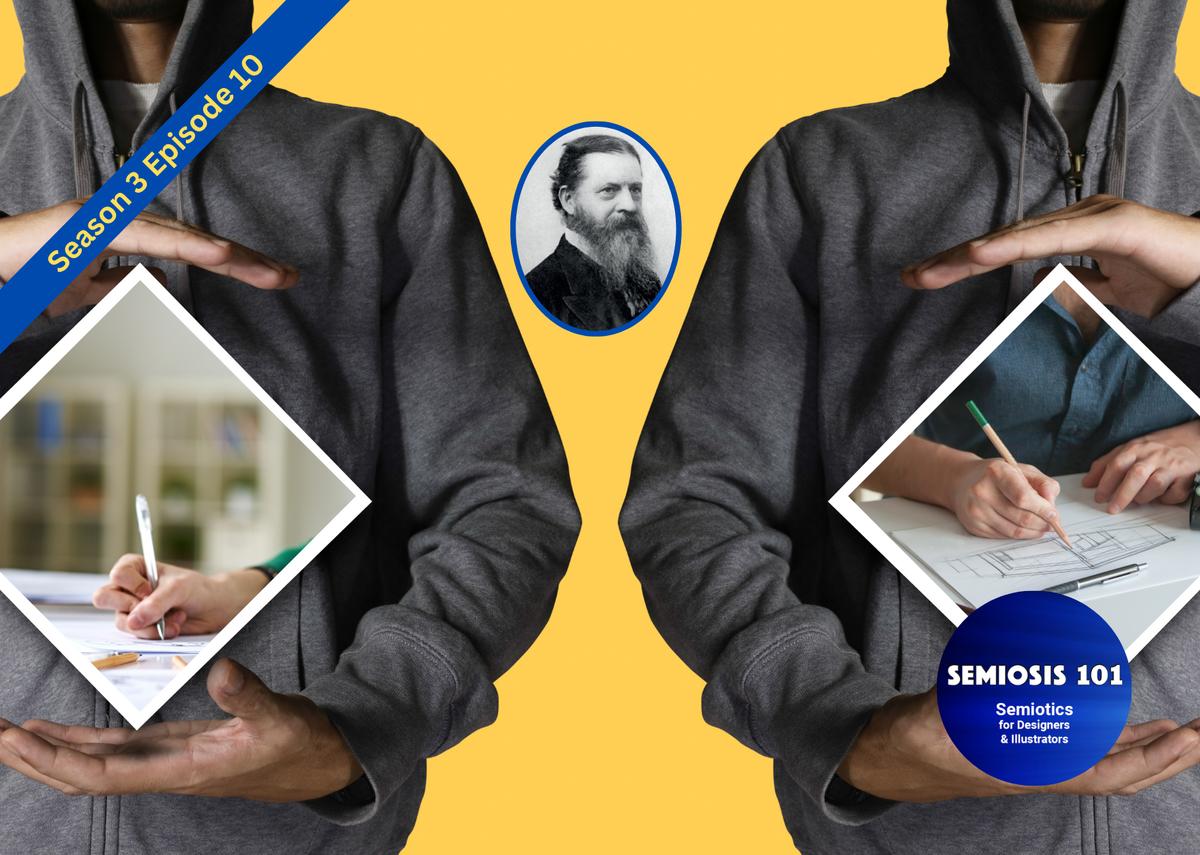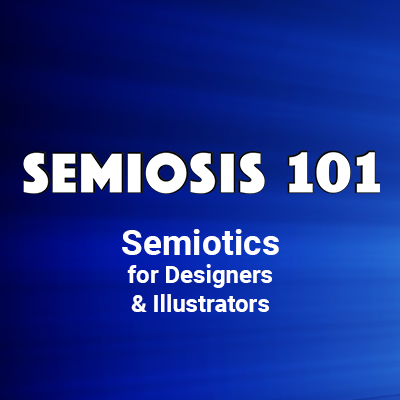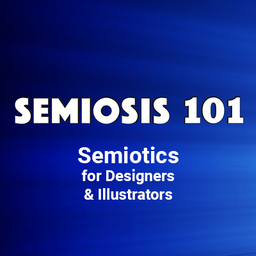Free Semiosis 101 Transcript 3.10:

SKETCHING SEMIOTICALLY: The Divergent-Convergent Creative Process
Hello readers.
In this free transcript for the episode published on Semiosis 101 on 3rd January 2024, we discuss semiotics at the ideation stage. Ideation is not about finished aesthetic qualities, but meaning-bearing qualities. It is these that have the potential to visually communicate the ask of the brief. Semiosis can help you finesse this important stage.
Watch the free episode on YouTube for the full impact…
…and here is the episode’s transcript.
You ideate. I ideate. We all ideate. We just call ideation different things. No design or illustration comes fully formed into the world. Your first idea is not the solution.
Ideation. Development. Sketching. Whatever you wish to call your first stage in the creative process of answering a client’s brief already embeds semiotics. You just may not realise you are doing this. Hit subscribe to this YouTube channel, and I will explain…
In the last episode I left you all with the revelation that you have already been encoding semiotic signs. Does this mean Semiosis 101 has made itself redundant? Obviously not.
The reality as you are all aware from my statement is that without perceiving it, every aesthetic decision you make has the potential to be meaning-bearing. Yes every line, mark, shape, colour, you manipulate has the potential for bearing meaning. But what meaning? Visual miscommunication can be made. Your audience can perceive alternate meanings from your visual communication outputs. Or, worst case scenario, the audience just does not perceive at all what you are trying to visually communicate.
Semiosis, as a pragmatic semiotic theory, just provides creatives with a framework to strengthen the visual communication of your intended visual messages. This all begins with sketching ideas.
Two episodes back I described the ideation process. Whatever you call the ideas development stage, that is the stage I am referring to. Brief > Research > Idea Generation > Idea Selection > Idea Development > Outcome.
This is the broad brush description of a design process, if we focus in on just the stages of ideation. Ideation is concerned with the generation of ideas to solve the brief’s problem, from insights your research has gleaned.
“Great. Ideation is all about getting ideas. I get it!”
No.
Ideation is more than “getting ideas.” Which ideas will be best to drop and which ideas should be developed? That is a focus of the creative after generating ideas.
“Okay. Check! Get ideas. Drop some. Take some forward. Can I get to the computer now and get on with the creative bit?”
I do enjoy adopting an impatient student character on these Semiosis 101 episodes. Which ideas should be dropped, which ideas have potential, and which ideas can be combined to make better solutions is a qualitative decision. I am not going to tell you how to do your job. After all, this is Semiosis 101, and my agenda is encoding semiotics to enhance visual communication. Instead I am going to point out the obvious.
Visually sketching ideas and then selecting the best ideas to take forward is predicated on an important point.
“Is that how good I can make it look using Adobe Photoshop?”
I think you know where I am coming from.
At this ideation stage, it is not about finished aesthetic qualities, but meaning-bearing qualities. It is these that have the potential to visually communicate the ask of the brief. Which idea or ideas help visually communicate what you need to visually communicate? Who says? You?
“Well, I like this one. I can do that really well in Adobe Illustrator.”
(You can tell as a lecturer I have heard it all. As I write this episode the new teaching year is one week away!)
Remember we do not design or illustrate for ourselves first. We need to centre the primary target audience in our creative process. So to decide which ideas have potential it is the audience who will decide. You encode meaning. The audience has to decode meaning. Get that process wrong and you will miscommunicate. Get it right, well…
…well, Semiosis can help you finesse this important stage to enhance visual communication. Remember the final ideation stage is development. If you want to know more about your target audience then check out most of season two’s episodes. The encoding of semiotic sign-action (aka Semiosis) begins for the creative at the basic level. Peirce calls this Iconic representation.
This is a qualitative point, where creatives play with visualising their ideas through rough sketches. With each sketched idea, the creative is trying ways to convey ideas through familiar qualities to things already known to the audience. These visual qualities, using Iconic lines, marks, shapes, colours, etc., form very basic images of things that resemble more complex things.
Now you realise this, Semiosis has a toe-hold into your existing creative process to gain semiotic momentum. Let us quickly put Semiosis and ideation into a design process from start to finish. We will use the Design Council’s double-diamond diagram.
The Design Council’s double-diamond design process diagram is a great way to frame what any creative does, when they work on any commercial job. Whether you are a designer or an illustrator, your individual creative process maps to this double-diamond. Let us look at the diamonds as more than a linear process (if it was linear it would be a straight line!)
From the starting point on the left-hand side of the first diamond, the creative begins a period of researching and initial ideas. This is a divergent phase as the creative’s researching and lateral thinking explodes in all directions. During this phase, the creative can also get valuable insights into their target audience’s needs and shared lived experiences. These insights will help the Iconic representation with likely familiar qualities to resemble known things.
In the second half of the first diamond, the creative process enters the second selective phase of ideation. At some point in both research and idea generation you have to begin to converge. Which ideas would help visually communicate the client’s brief’s concept to the target audience? At this stage what visual Iconic qualities will help ‘hook’ the target audience’s attention?
By seeking the answer to this through analysing and selecting the best ideas, the creative can also move forward to finessing their chosen visual language. When we use such a term, it refers to the visual qualities the creative employs to visually communicate. As we can see, as soon as a creative begins to finesse their rough sketched ideas, they are simply finessing the Iconic building blocks of visual communication.
As a creative begins to develop their suitable idea(s) toward the final output (whether a designed publication or a set of illustrations), they enter the second diamond. Once more, from a creative position of a suitable idea to develop to publication, the creative enters a second period of divergence. This is when they try all the tricks in their tool box, to ensure the output will answer the brief. But will it successfully communicate its intended message to the target audience?
As this final finessing phase begins, the creative revisits their creative decisions to ensure they are not mis-communicating. This final stage not only focuses on professional finishing services, but also on tweaking the encoded semiotic sign-action. This ensures a successful interpretation of what is meant to be communicated.
In each double-diamond step each creative will have their own process on how to diverge/converge. It is fluid, messy and certainly not a clean linear step-by-step procedure. When my young undergraduates begin to develop their own creative practice, they sometimes find it hard to break free from their software comfort zones, into lateral thinking and problem-solving.
Semiosis offers the creative a qualitative process of improving any visual meaning-bearing elements. Does the few brush strokes in an illustration visually communicate a tree, or does it look like something else? Does the composition of several graphic elements in a page layout support the tone of voice and theme, or does the negative space between the elements now look like a Nazi swastika? The structure that a strong ideation process, within a larger creative process of diverge/converge/diverge/converge, offers designers and illustrators a scalable, repeatable professional work plan.
By embedding the framework of Semiosis into your creative process, it provides you with applicable ways to successfully encode connotative meaning into your outcomes. By applying Semiosis you can use the encoded semiotic sign-action it affords you to improve the success of the visual communication. Semiosis will help you to help your target audience to successfully interpret what is intended, and reduce the miscommunication. Come back next week when we will begin four episodes to dig deeper into how your target audience interprets.
We are currently half-way through season three, and we have a lot more to explore. So remember to subscribe.
Semiosis 101 Semiotic Design Resources is a reader-supported publication. To receive exclusive posts and support my work, consider becoming a free or paid subscriber. Paid subscribers get name checked on all future Semiosis 101 YouTube episodes.
===Semiosis 101 Patreon Producer==============
Become a Semiosis 101 Patreon Producer and get a named producer credit on future video episodes, plus watch all new episodes months ahead of YouTube.
===Semiosis 101 Patreon Exclusives==============
Watch longer Patreon-exclusive Semiosis 101 episodes on applying Semiosis into design and illustration…
PATEXC001 How does semiotics work in illustration?





